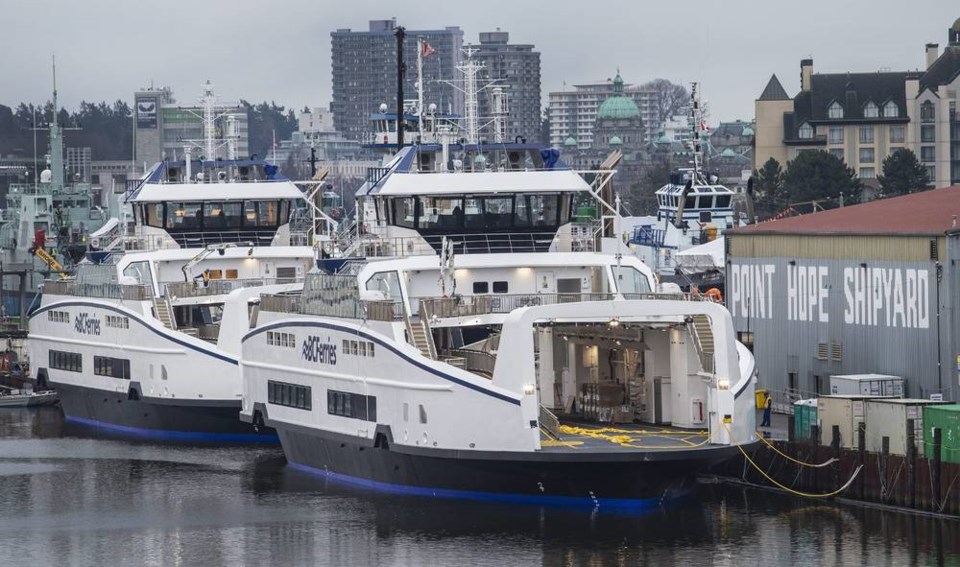A commentary by the director of marine climate action at Oceans North, which supports marine conservation in partnership with Indigenous and coastal communities.
Last week, B.C. Ferries announced a proposal to electrify one-third of its fleet over a seven-year period.
The ambitious plan, which calls for construction of seven new ferries and conversion of six others, is a direct response to Premier John Horgan’s campaign promise to “launch a long-term B.C. shipbuilding strategy to create good jobs and bring more work to B.C. shipyards.”
The proposal could not have come at a better time. Apart from being “one of the most sweeping carbon-reduction initiatives in the marine industry worldwide,” it calls for the work to be done in Canadian shipyards.
Finance ministers throughout the country are busy working out the details of their upcoming budgets and engaging Canadians for new ideas to rebuild the economy.
In order to address both the economic devastation caused by COVID-19 and the climate crisis at the scale and pace necessary, there are few better places to get started than by decarbonizing Canada’s domestic ferry fleet.
While ferries might seem like a small step, a commitment to decarbonize the country’s approximately 180 transit ferries by 2030 is exactly what is needed to set the country’s broader shipping sector on a path to net-zero emissions.
Globally, the shipping industry accounts for about 80 per cent of world trade and more than one billion tonnes of greenhouse-gas emissions per year — more than any but the top-five emitting countries.
Without concrete steps to transition away from fossil fuels, shipping emissions could represent 10 per cent of global greenhouse gas emissions by 2050. Canada has a responsibility to help reduce global shipping emissions, starting at home.
To meet the Paris goals for a livable planet and achieve Canada’s target of net-zero emissions by 2050, a major segment of the country’s vessels will need to run on clean fuels by 2030.
Canada should embrace B.C. Ferries’ made-in-Canada plan and use it as springboard for the development of a national clean ferries program, similar to its plan to build 5,000 zero-emission transit buses.
A national ferry program would help drive the market for zero-emission shipping technologies such as electric batteries and hydrogen fuels cells while filling a critical gap in Canada’s Strengthened Climate Plan by harnessing the potential of the maritime sector.
Canada needs to move quickly if it wants to become a leader in this field, or even be in a position to meet its own commitments.
By 2022, it is predicted that there will be more than 70 battery-powered ferries operating on Norwegian fjords. At present, the number of zero-emission vessels in Canada can be counted on one hand.
Apart from B.C. Ferries’ diesel-electric hybrids, the Island Aurora and the Island Discovery, there is the Marilyn Bell I — servicing a short route between Toronto and Toronto Island — and the Amherst Islander II and the Wolfe Islander IV, which will provide service on the Saint Lawrence River.
Transitioning Canada’s ferry fleet to zero emissions in less than a decade may seem like an impossible task, but history has shown us it can be done.
As part of Canada’s war production effort, Canadian shipyards built more than 400 merchant ships in four years from a standing start in 1941. A similar effort will be required for Canada to do its part to prevent global temperatures from rising more than 1.5° C.
Taking action at this scale can also provide serious economic benefits, as the results of the National Shipbuilding Strategy have made clear.
In 2017, PwC published a report looking at the economic impact of building 15 modern frigates in Canada. It found that for every $1 billion spent in Canada, it generated up to $1.3 billion for the Canadian economy and created 8,000 jobs.
Not only does a made-in-Canada domestic shipbuilding strategy generate tremendous economic growth, it is also less expensive than having other countries build our ships: the PwC report found that it is between 29 per cent and 42 per cent less expensive to “Build in Canada” after taking into account tax revenue.
While the upfront cost of made-in-Canada ferries may come at a premium, savings in operations and maintenance, regulatory incentives for switching to clean fuels and economies of scale will all come together to drive down costs.
With the government under pressure to both address the climate crisis and rebuild the economy, building clean maritime transit could provide thousands of new jobs and economic stimulus from coast to coast to coast.
Canadian companies such as Ballard, Corvus Energy and Hydrogenics are already at the forefront of the technological transition to zero-emission shipping in other countries.
A national clean ferry program would lay the foundation for a domestic shipbuilding industry that can build Canada’s future fleet and catapult us into the race for a share of the trillion-dollar market opportunity associated with zero-emission fuels and marine technology.
It’s a clear example of a good climate policy that is also a good economic policy.



